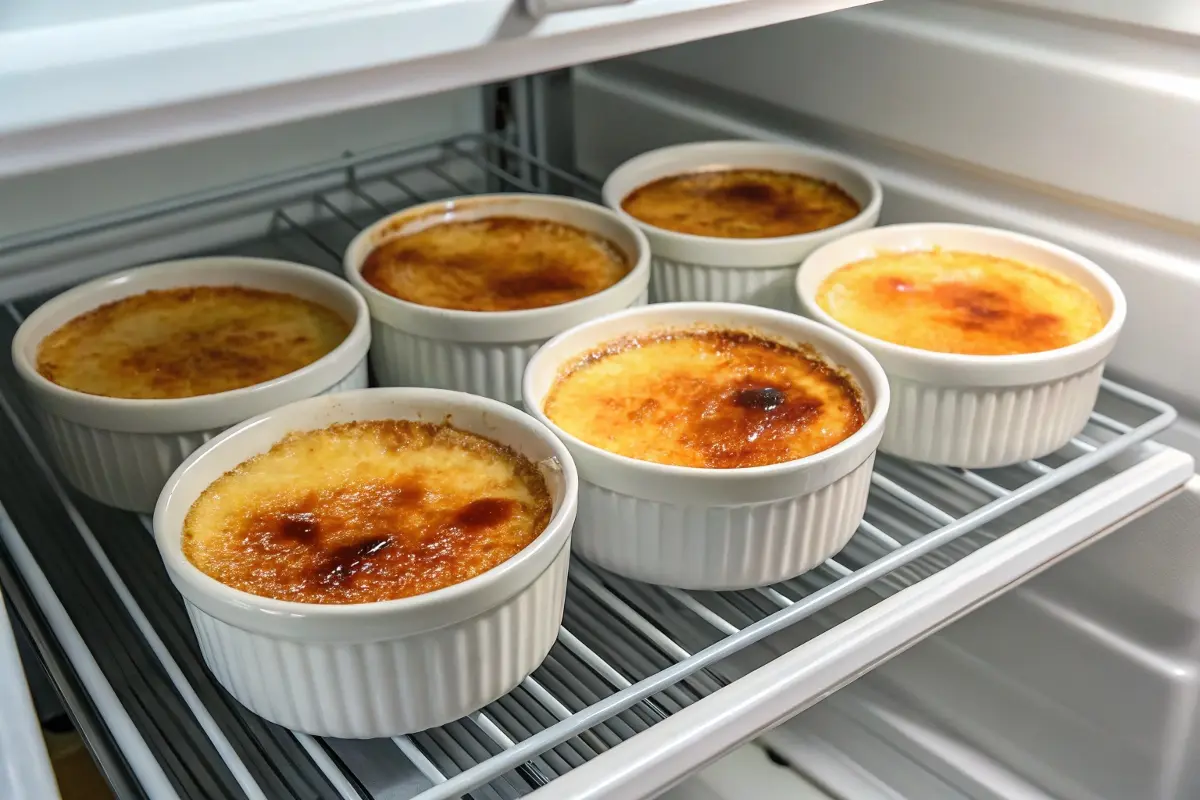Understanding Crème Brûlée: A Classic Dessert
Crème brûlée is a timeless dessert known for its rich, creamy custard and crisp caramelized sugar topping. While this treat is a favorite in many households, questions often arise about how best to store it and how long it remains fresh. Let’s dive into all the details to ensure your dessert stays delicious.

History and Origin of Crème Brûlée
This dessert’s story is as rich as its flavor. With origins traced back to 17th-century Europe, crème brûlée gained fame under French cuisine but has variations in Spanish and English traditions. Its luxurious texture and unique caramelized crust make it a universal favorite.
Key Ingredients That Define This Dessert
The magic of this dish lies in its simplicity. It requires:
- Heavy Cream: The base for a smooth custard.
- Egg Yolks: For richness and structure.
- Sugar: To sweeten the custard and create the caramelized crust.
- Vanilla: Adds a fragrant, signature flavor.
Storage of Crème Brûlée: Best Practices
Proper storage ensures your dessert stays fresh and tasty. With its delicate custard and sugar topping, handling it with care is crucial.
Refrigerating the Dessert
To store your dessert:
- Cool It Down: Allow it to reach room temperature before refrigeration.
- Use Airtight Containers: Prevent absorption of odors by sealing it tightly.
- Protect Layers: Separate servings with parchment paper to preserve the sugar crust.
💡 Pro Tip: Always refrigerate your custard-based dessert within two hours of preparation to prevent bacterial growth.
Freezing for Longer Storage
Freezing is an option for preserving it longer, but it can affect the custard’s texture.
- No Sugar Topping: Add the caramelized layer after thawing.
- Seal Properly: Use a freezer-safe container to prevent ice crystals.
- Label with Dates: Consume frozen portions within one month for best results.
Thaw overnight in the refrigerator and add the caramelized sugar topping before serving.

Shelf Life: How Long Is It Safe to Eat?
Properly refrigerated, this dessert lasts about 3–4 days before it begins to lose its texture and flavor. Homemade versions, lacking preservatives, have a slightly shorter window. Always rely on your senses to assess freshness.
How to Identify Spoiled Crème Brûlée
Not sure if your burnt cream is still good? Look out for these signs:
- Off Smell: A sour or eggy odor means it’s time to toss it.
- Weird Texture: If the custard looks watery or grainy, it’s past its prime.
- Mold: Any visible mold is a clear sign to discard it immediately.
💡 Trust your senses! When in doubt, it’s better to be safe than sorry.
Does Homemade Crème Brûlée Have a Shorter Shelf Life?
Yes, homemade burnt cream often has a shorter shelf life compared to commercially prepared versions. This is because it lacks preservatives. Always prioritize freshness by consuming homemade burnt cream within three days.
Preserving Crème Brûlée for Longer
Is there a way to extend the life of this delicious dessert? Absolutely!
The Role of Ingredients in Shelf Life Extension
The quality of your ingredients plays a huge role in how long your crème brûlée lasts. Using fresh cream and eggs ensures a longer-lasting custard. Additionally, proper cooking techniques—like not overbaking—help maintain its texture.
Using Airtight Containers for Optimal Storage
Airtight containers aren’t just handy—they’re essential. They prevent the custard from drying out and shield it from odors. Plus, they’re a lifesaver when transporting burnt cream for events or gatherings.
Freezing Crème Brûlée: What You Need to Know
Freezing is ideal for long-term storage but remember the golden rule: caramelize the sugar topping only after thawing. This keeps your crème brûlée tasting as fresh as possible.
Recipe for Crème Brûlée
Want to make your own crème brûlée? Here’s an easy recipe to try!
Ingredients:
| Ingredient | Quantity |
|---|---|
| Heavy cream | 2 cups |
| Egg yolks | 5 large |
| Sugar | 1/2 cup |
| Vanilla extract | 1 teaspoon |
| Sugar (for topping) | 3 tablespoons |
Preparation Method:
- Preheat your oven to 325°F (160°C).
- Heat the cream in a saucepan until just simmering, then remove from heat.
- In a bowl, whisk the egg yolks and sugar until pale and creamy.
- Gradually add the warm cream to the yolk mixture, stirring constantly.
- Stir in the vanilla extract.
- Pour the mixture into ramekins and place them in a baking dish. Add hot water to the dish to create a water bath.
- Bake for 30–40 minutes or until the custard is set but still slightly jiggly in the center.
- Cool to room temperature, then refrigerate for at least 4 hours.
- Before serving, sprinkle sugar on top and caramelize with a kitchen torch.
Enjoy your homemade masterpiece! 😍
Reheating Crème Brûlée: Is It Possible?
You might be wondering if reheating burnt cream is a good idea. After all, we’ve all faced moments when a dessert seems too good to finish in one sitting. But reheating a dessert as delicate as burnt cream requires some finesse.
The Best Way to Reheat Crème Brûlée
Reheating crème brûlée is not impossible, but it’s tricky. To preserve its texture, focus on reheating just the custard (not the caramelized sugar topping). Here’s how:
- Preheat Your Oven: Set your oven to 300°F (150°C).
- Use a Water Bath: Place the ramekin in a baking dish and add warm water halfway up the sides to prevent overheating.
- Cover Loosely: Use aluminum foil to cover the dish, allowing steam to escape.
- Reheat Gently: Heat for 10–15 minutes, checking frequently to ensure it doesn’t overcook.
💡 Note: If you’ve already added the sugar topping, it will lose its crunch during reheating. Consider adding a fresh sugar layer and caramelizing it again.
How Reheating Affects the Texture and Flavor
Unfortunately, reheating can slightly alter the dessert’s creamy texture, making it a little denser. The flavor, however, remains intact. If you’re a fan of the custard’s original silky feel, reheating might not be your favorite option.
Common Problems and Solutions for Crème Brûlée Storage
Even the most experienced bakers encounter hiccups when storing crème brûlée. Here are some common issues and practical fixes to keep your dessert in tip-top shape.
Why Does Crème Brûlée Lose Its Texture Over Time?
The custard’s texture can change due to moisture loss or improper storage. Over time, the dessert may become rubbery or develop an uneven consistency.
Solution: Always store burnt cream in an airtight container and consume it within the recommended timeframe (3–4 days in the fridge).
Solving the Problem of Watery Crème Brûlée
Watery crème brûlée is a sure sign of improper refrigeration or overbaking. The custard may weep, creating a puddle of liquid at the bottom.
Solution: Avoid storing warm custard in the fridge, as condensation can lead to water buildup. If preparing at home, ensure you bake it at the right temperature and time.
How to Elevate Your Crème Brûlée Experience
If you’ve mastered storing and preparing crème brûlée, why not take it to the next level? This dessert is versatile and can be customized to suit any occasion or personal preference. Here’s how to make your burnt cream experience unforgettable:
Experiment with Flavors
Traditional vanilla crème brûlée is delightful, but there’s a whole world of flavors to explore. Try these creative twists:
- Chocolate Crème Brûlée: Add melted dark chocolate to the custard for a rich, decadent treat.
- Coffee Infusion: Stir in a shot of espresso or some coffee extract for a mocha-inspired dessert.
- Fruit Varieties: Infuse the cream with citrus zest, like orange or lemon, for a refreshing twist, or top the finished dessert with fresh berries for a burst of flavor.
Play with Presentation
Crème brûlée doesn’t have to be confined to ramekins. Impress your guests by serving it in unique dishes like teacups, martini glasses, or mini mason jars. A visually appealing presentation can elevate this dessert into a show-stopping centerpiece.
Pair It with Perfection
Pairing burnt cream with complementary drinks or sides can enhance its flavors. Consider these options:
- Dessert Wines: A sweet wine like Sauternes or Moscato balances the caramelized sugar’s richness.
- Espresso or Cappuccino: The bitterness of coffee contrasts beautifully with the dessert’s sweetness.
- Shortbread Cookies: A light, buttery cookie adds texture and pairs wonderfully with the custard.
Perfecting the Sugar Crust
The caramelized sugar crust is the star of burnt cream, and getting it right makes all the difference. Use these tips:
- Even Layering: Sprinkle an even layer of sugar to ensure uniform caramelization.
- Torch Techniques: Move the flame in slow, circular motions to avoid burning one spot.
- Alternative Sugars: Experiment with raw sugar, brown sugar, or turbinado sugar for unique flavors and textures.
Hosting a Crème Brûlée Night
Why not make burnt cream the centerpiece of your next gathering? Create a DIY station where guests can personalize their desserts with various toppings, like chocolate shavings, nuts, or flavored whipped creams. It’s a fun and interactive way to enjoy this classic treat.
💡 Pro Tip: Keep some pre-made custards on hand to save time while letting guests have fun with the toppings and torching their own sugar crusts.

FAQs:
Let’s tackle some of the most frequently asked questions about storing and enjoying burnt cream.
Can you eat crème brûlée after 5 days?
While technically safe if stored properly, burnt cream’s flavor and texture degrade after 4 days. For the best experience, consume it within this window.
Is it safe to eat crème brûlée left out overnight?
No, it’s not safe to eat crème brûlée that has been left out for more than 2 hours. The custard contains dairy and eggs, which spoil quickly at room temperature.
How can I tell if my crème brûlée has gone bad?
Look for signs like a sour smell, changes in texture (like separation or wateriness), or visible mold. If you notice any of these, it’s time to toss it.
Can you freeze crème brûlée with the caramelized topping?
It’s better to freeze crème brûlée without the topping. The caramelized sugar becomes sticky and loses its crunch when thawed. Add the sugar topping just before serving.
What’s the best way to transport crème brûlée?
Use airtight containers to prevent spills and ensure the custard remains stable during transport. Keep it refrigerated or in a cooler if traveling long distances.
Can I use low-fat ingredients in crème brûlée?
Low-fat options can be used, but they may affect the dessert’s creamy texture. Full-fat cream and fresh eggs yield the best results.
What’s the difference between crème brûlée and custard?
While both are custard-based desserts, crème brûlée is distinguished by its caramelized sugar topping, giving it a signature crunch. Custard desserts like flan or pudding do not have this layer. Crème brûlée is also usually richer, thanks to the heavy cream used in its recipe.
Why does crème brûlée taste so good?
Crème brûlée’s appeal lies in its perfect balance of flavors and textures. The creamy, velvety custard contrasts beautifully with the crackling caramelized sugar crust. Add the hint of vanilla, and it becomes a dessert that’s both luxurious and comforting.
Can you use milk instead of heavy cream in crème brûlée?
Yes, but substituting milk for heavy cream will result in a lighter custard with a thinner texture. For the classic richness that crème brûlée is known for, heavy cream is recommended. However, whole milk or a milk-and-cream mixture can work as a lower-fat alternative.
Conclusion: Keeping Your Dessert Fresh
By storing your dessert properly and consuming it promptly, you can enjoy crème brûlée at its best. Whether it’s homemade or from a bakery, understanding the principles of refrigeration, freezing, and ingredient quality ensures you savor every bite.
